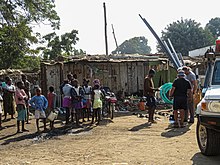
Summary
Squatting in Angola occurs when displaced peoples occupy informal settlements in coastal cities such as the capital Luanda. The Government of Angola has been criticized by human rights groups for forcibly evicting squatters and not resettling them.


History edit
Between 1575 and 1975, Angolan territory was partially colonised as Portuguese Angola. In the late 18th-century and early 19-century, escaped slaves joined with bandits to attack the Portuguese. There was also resistance from indigenous peoples such as the Herero and the Nyaneka. The latter squatted ancestral lands after being displaced from them.[1]
Angola became independent in 1975, then the Angolan Civil War began, lasting until 2002 and displacing an estimated 4 million people.[2][3] In 1975, the capital Luanda had 0.5 million inhabitants and by 2011 its population was 10 million of which 7 million lived in slums scattered across the city. In these squatted informal settlements known as musseques, 55 per cent have electricity and 12.4 per cent have running water.[2] War accelerated the process of urbanization since Luanda and other coastal cities were perceived to be safer places than the interior.[3] The first slums dated back to the colonial era and since then more have been founded. Since 2002, a city-wide gentrification process in Luanda has led to evictions for shopping centres and luxury homes.[2]
In 2007, Amnesty International and Christian Aid criticised the government for forcibly evicting squatters and not resettling them. In one instance, the Catholic church had requested that 2,000 families be removed.[4] As well as occupying land, people also squatted buildings left derelict after being damaged in the civil war.[5] Human Rights Watch recorded an eviction of at least 5,000 people in 2013 from a shanty town in Maiombe, Luanda.[6]
References edit
- ^ Clarence‐Smith, W. G. (1985). "Runaway slaves and social bandits in Southern Angola, 1875–1913". Slavery & Abolition. 6 (3): 23–33. doi:10.1080/01440398508574891. ISSN 0144-039X.
- ^ a b c Barros, Carlos Pestana; Balsas, Carlos J. L. (2019). "Luanda's Slums: An overview based on poverty and gentrification". Urban Development Issues. 64 (1): 29–38. doi:10.2478/udi-2019-0021. S2CID 210714581.
- ^ a b Cain, Allan (2007). "Housing microfinance in post-conflict Angola. Overcoming socioeconomic exclusion through land tenure and access to credit". Environment and Urbanization. 19 (2): 361–390. doi:10.1177/0956247807082819. S2CID 154536722.
- ^ Biles, Peter (15 January 2007). "Angola 'made thousands homeless'". BBC News. Retrieved 10 April 2021.
- ^ Deverajan, Shanta (9 February 2011). "Luanda's vertical slums". World Bank. Retrieved 10 April 2021.
- ^ "Angola: Scores Detained, Convicted After Forced Evictions". Human Rights Watch. 26 February 2013. Retrieved 10 April 2021.


